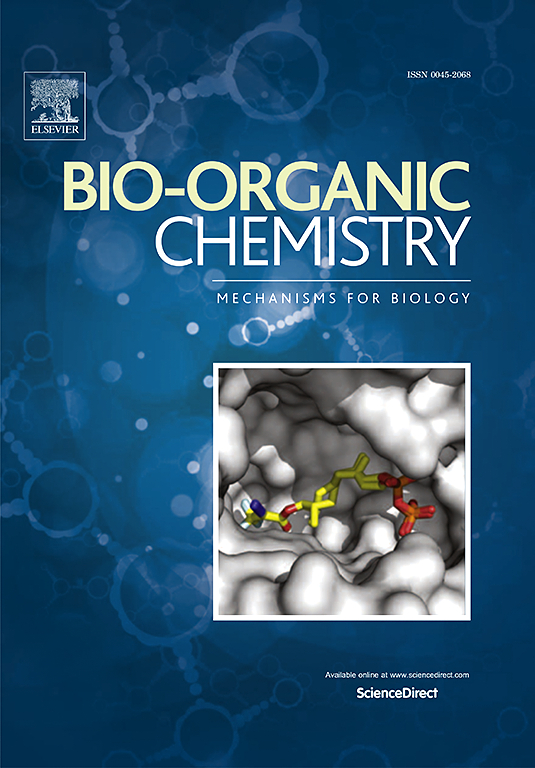Identification of CH2-linker modified desfluoroquinolone-aminopyrimidine hybrids to combat antibiotic-resistant gram-positive bacteria
IF 4.5
2区 医学
Q1 BIOCHEMISTRY & MOLECULAR BIOLOGY
引用次数: 0
Abstract
The increasing prevalence of antibiotic-resistant bacterial infections has emerged as a major public health crisis, necessitating an urgent need for the development of new antimicrobial agents. In this manuscript, structural modifications were conducted on the CH2 linker of the antibacterial desfluoroquinolone-aminopyrimidine hybrids that we had previously obtained, resulting in compounds A7, B1, and D6. These three compounds exhibited potent activity against a panel of antibiotic-resistant Gram-positive bacteria, including fluoroquinolone-resistant Staphylococcus aureus, linezolid-resistant Staphylococcus aureus, vancomycin-intermediate Staphylococcus aureus (VISA), and vancomycin-resistant Enterococcus faecium. Particularly, despite their structural similarity to classical quinolones, compounds A7, B1, and D6 exhibited no cross-resistance with ciprofloxacin. Additionally, the difluorinated CH2-linker modified compound demonstrated enhanced metabolic stability. These promising results encourage us to move forward to the next phase of structural optimization, with a specific focus on reducing mammalian cytotoxicity.

ch2连接体修饰的去氟喹诺酮-氨基嘧啶杂合体对抗耐药革兰氏阳性菌的鉴定
耐抗生素细菌感染的日益流行已成为一项重大的公共卫生危机,迫切需要开发新的抗微生物药物。在本文中,我们对先前获得的抗菌去氟喹诺酮-氨基嘧啶杂合体的CH2连接体进行结构修饰,得到化合物A7、B1和D6。这三种化合物对一组耐抗生素的革兰氏阳性细菌,包括耐氟喹诺酮金黄色葡萄球菌、耐利奈唑胺金黄色葡萄球菌、万古霉素中间体金黄色葡萄球菌(VISA)和耐万古霉素屎肠球菌,显示出强有力的活性。特别是,尽管它们的结构与经典喹诺酮类药物相似,但化合物A7、B1和D6与环丙沙星没有交叉耐药。此外,二氟化ch2连接修饰的化合物显示出增强的代谢稳定性。这些有希望的结果鼓励我们进入结构优化的下一阶段,特别关注降低哺乳动物的细胞毒性。
本文章由计算机程序翻译,如有差异,请以英文原文为准。
求助全文
约1分钟内获得全文
求助全文
来源期刊

Bioorganic Chemistry
生物-生化与分子生物学
CiteScore
9.70
自引率
3.90%
发文量
679
审稿时长
31 days
期刊介绍:
Bioorganic Chemistry publishes research that addresses biological questions at the molecular level, using organic chemistry and principles of physical organic chemistry. The scope of the journal covers a range of topics at the organic chemistry-biology interface, including: enzyme catalysis, biotransformation and enzyme inhibition; nucleic acids chemistry; medicinal chemistry; natural product chemistry, natural product synthesis and natural product biosynthesis; antimicrobial agents; lipid and peptide chemistry; biophysical chemistry; biological probes; bio-orthogonal chemistry and biomimetic chemistry.
For manuscripts dealing with synthetic bioactive compounds, the Journal requires that the molecular target of the compounds described must be known, and must be demonstrated experimentally in the manuscript. For studies involving natural products, if the molecular target is unknown, some data beyond simple cell-based toxicity studies to provide insight into the mechanism of action is required. Studies supported by molecular docking are welcome, but must be supported by experimental data. The Journal does not consider manuscripts that are purely theoretical or computational in nature.
The Journal publishes regular articles, short communications and reviews. Reviews are normally invited by Editors or Editorial Board members. Authors of unsolicited reviews should first contact an Editor or Editorial Board member to determine whether the proposed article is within the scope of the Journal.
 求助内容:
求助内容: 应助结果提醒方式:
应助结果提醒方式:


